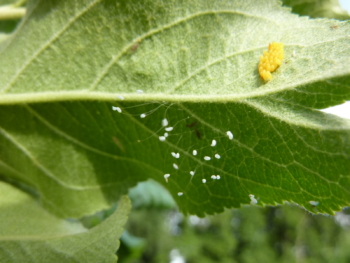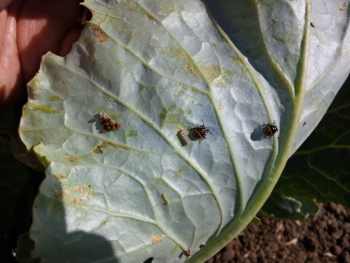Tipsheet: Organic Pest Management
By Rex Dufour, NCAT Agriculture Specialist

Three 2nd-instar cabbage loopers creating “window pane” damage on cabbage. Regular monitoring will help alert the farmer to potentially damaging infestations. Photo: Rex Dufour, NCAT
How Organic Pest Management Works
Pest management in organic systems necessarily relies on preventing pest problems from becoming economically damaging. Prevention, in turn, relies on maintaining a vibrant and healthy soil ecology, as well as supporting biodiversity above ground through diverse rotations, providing habitat for beneficial organisms, and reducing habitat for pests. When preventative measures, which include physical and cultural controls, are not able to control pest populations, the option of last resort is the use of allowed pesticides.
Regular monitoring of your crop (buy a hand lens!) will provide information about the status of both pest and beneficial populations. It is important to be able to identify which critters are pests, which are beneficials, and which are “neutral,” as well as the various life stages of pests and beneficials and what they eat. Organic pest management may include the use of pheromone traps, release of beneficial insects, use of trap crops, and other organically approved techniques (see “USDA Organic Regulations Relating to Pest Management” below).
Organic Pest Management Basics

Knowing life stages of beneficials is important for organic growers. Green lacewing eggs are the white eggs on “stems,” while the yellow eggs are ladybird beetle eggs. Larvae of lacewings and ladybird beetles (as well as adult ladybird beetles) are important predators of soft-bodied insects such as aphids. Photo: Rex Dufour, NCAT
Healthy soils are the basis of good pest management because they support plant health and resilience—the ability of the plant to recover from pest damage. If possible, plant cultivars that are resistant to some of the main pests (diseases, nematodes, and insects) in your area. Beyond that, understanding the lifecycles of both pests and beneficials is important so that habitat can be developed to support the “good guys.” Correct identification of pest damage early in the cropping cycle is important, so that effective options can be considered to reduce pest populations and damage. Insects can also be disease vectors, so recognizing the symptoms of common (insect-vectored) diseases and knowing your organic management options is valuable. Knowledge of the lifecycles of important pests can provide an early warning if large numbers of egg masses or immature forms of the pest are observed when monitoring. Understanding lifecycles will also provide some insight into which phase(s) of the pest lifecycle is most susceptible to management strategies.
Exclusion—keeping a pest out of a field, bed, hoophouse or greenhouse—is a useful concept in organic production, particularly for hard-to-manage soil-born pests (i.e., phytophthora and nematodes) and insect pests. Clean equipment and tools can help prevent soil pests from inadvertently spreading from one field to another. To prevent insect infestations, use good screening at doors and vents of hoop houses and greenhouses. For bedded plants grown outdoors, floating row covers can prevent some early-season infestations until plants are robust enough to outgrow the pests.
If treatment with an organically approved pesticide becomes necessary, remember that these are most effective when plant surfaces are well covered. Sufficient pressure, combined with appropriate nozzle selection and positioning, will promote good coverage.
Useful Tools for Pest Management
- Develop a small library of pest-management reference materials.
- Identify local experts (entomologists, plant pathologists, soil scientists) who are willing to respond quickly to questions.
- Learn major pests (and their natural enemies!) of your main crops, understand their lifecycles, and learn how to use a hand lens. Train other workers on your farm on pest and damage ID, as well.
- Take digital pictures of unknown pests/plant symptoms and send them to local experts for identification.
- Have at least a good-quality backpack sprayer; larger farmers may want to have a tractor-based spray rig with internal agitation.
The National Organic Program requires that growers have an Organic System Plan (OSP), a document that essentially details all activities and inputs on the farm. The OSP includes a pest-management component with a listing of any pest-management practices and inputs used on the farm.
USDA Organic Regulations Relating to Pest Management
The organic standard in 7 CFR §205.206 for crop pest, weed, and disease management specifies the following:
(a) The producer must use management practices to prevent crop pests, weeds, and diseases including but not limited to:
(1) Crop rotation and soil and crop nutrient management practices, as provided for in §§205.203 and 205.205;
(2) Sanitation measures to remove disease vectors, weed seeds, and habitat for pest organisms; and
(3) Cultural practices that enhance crop health, including selection of plant species and varieties with regard to suitability to site-specific conditions and resistance to prevalent pests, weeds, and diseases.
(b) Pest problems may be controlled through mechanical or physical methods including but not limited to:
(1) Augmentation or introduction of predators or parasites of the pest species;
(2) Development of habitat for natural enemies of pests;
(3) Nonsynthetic controls such as lures, traps, and repellents.
(c) Weed problems may be controlled through:
(1) Mulching with fully biodegradable materials;
(2) Mowing;
(3) Livestock grazing;
(4) Hand weeding and mechanical cultivation;
(5) Flame, heat, or electrical means; or
(6) Plastic or other synthetic mulches: Provided, that, they are removed from the field at the end of the growing or harvest season.
(d) Disease problems may be controlled through:
(1) Management practices which suppress the spread of disease organisms; or
(2) Application of nonsynthetic biological, botanical, or mineral inputs.
(e) When the practices provided for in paragraphs (a) through (d) of this section are insufficient to prevent or control crop pests, weeds, and diseases, a biological or botanical substance or a substance included on the National List of synthetic substances allowed for use in organic crop production may be applied to prevent, suppress, or control pests, weeds, or diseases: Provided, That, the conditions for using the substance are documented in the organic system plan.
(f) The producer must not use lumber treated with arsenate or other prohibited materials for new installations or replacement purposes in contact with soil or livestock.

Harlequin stink bug egg masses, first instar hatchlings and 4th instar nymphs. These stink bugs can be a pest on greens and brassicas in late spring and summer. Identifying pest eggs can provide the grower a heads-up on possible future infestations. Photo: Rex Dufour, NCAT

Use of pesticides is a last resort in organic production. This grower
had an infestation of cabbage loopers that was likely to cost him more money than the cost of controlling the pest, so he applied
one of several organically allowed formulations of Bacillus thuringiensis (Bt). Bt-based pesticides are generally most effective against smaller-sized caterpillars, but this picture shows a dead 3rd or 4th stage instar. It is important for growers to monitor the results of any pest management actions they implement to determine if they worked or not. Photo: Rex Dufour, NCAT
Further Resources
Farming with Native Beneficial Insects
This 2014 book from the Xerces Society discusses the ecology of native beneficial insects and how to increase their numbers on your farm.
Organic Materials Review Institute (OMRI)
USDA Organic Regulations 7 CFR 205
USDA National Organic Program Handbook
- NOP 2610: Sampling Procedures for Residue Testing
- NOP 2611: Laboratory Selection Criteria for Pesticide Residue Testing
- NOP 2611-1: Prohibited Pesticides for NOP Residue Testing
- NOP 2613: Responding to Results from Pesticide Residue Testing
- PM 11-4: Evaluation of Materials Used in Organic Crop, Livestock, and Handling Operations
- PM 13-3: Synthetic Algicides, Disinfectants, and Sanitizers Allowed in Organic Crop Production
USDA National List of Allowed and Prohibited Substances
Tipsheet: Organic Pest Management
By Rex Dufour, NCAT Agriculture Specialist
Published July 2015
© NCAT
IP404
This publication is produced by the National Center for Appropriate Technology through the ATTRA Sustainable Agriculture program, under a cooperative agreement with USDA Rural Development. This publication was also made possible in part with funding from U.S. Department of Agriculture’s Agricultural Marketing Service, National Organic Program. ATTRA.NCAT.ORG.


